Transform retail operations with Zebra’s retail technology solutions, featuring hardware and software for improving inventory management and empowering teams.
Streamline operations with Zebra’s healthcare technology solutions, featuring hardware and software to improve staff collaboration and optimise workflows.
Enhance processes with Zebra’s manufacturing technology solutions, featuring hardware and software for automation, data analysis, and factory connectivity.
Zebra’s transportation and logistics technology solutions feature hardware and software for enhancing route planning, visibility, and automating processes.
Zebra's public sector technology solutions enhance decision-making, streamline operations, and safeguard communities with advanced software and rugged hardware.
Zebra's hospitality technology solutions equip your hotel and restaurant staff to deliver superior customer and guest service through inventory tracking and more.
Zebra's market-leading solutions and products improve customer satisfaction with a lower cost per interaction by keeping service representatives connected with colleagues, customers, management and the tools they use to satisfy customers across the supply chain.
Empower your field workers with purpose-driven mobile technology solutions to help them capture and share critical data in any environment.
Zebra's range of mobile computers equip your workforce with the devices they need from handhelds and tablets to wearables and vehicle-mounted computers.
Zebra's desktop, mobile, industrial, and portable printers for barcode labels, receipts, RFID tags and cards give you smarter ways to track and manage assets.
Zebra's 1D and 2D corded and cordless barcode scanners anticipate any scanning challenge in a variety of environments, whether retail, healthcare, T&L or manufacturing.
Zebra's extensive range of RAIN RFID readers, antennas, and printers give you consistent and accurate tracking.
Choose Zebra's reliable barcode, RFID and card supplies carefully selected to ensure high performance, print quality, durability and readability.
Zebra's rugged tablets and 2-in-1 laptops are thin and lightweight, yet rugged to work wherever you do on familiar and easy-to-use Windows or Android OS.
With Zebra's family of fixed industrial scanners and machine vision technologies, you can tailor your solutions to your environment and applications.
Zebra’s line of kiosks can meet any self-service or digital signage need, from checking prices and stock on an in-aisle store kiosk to fully-featured kiosks that can be deployed on the wall, counter, desktop or floor in a retail store, hotel, airport check-in gate, physician’s office, local government office and more.
Adapt to market shifts, enhance worker productivity and secure long-term growth with AMRs. Deploy, redeploy and optimize autonomous mobile robots with ease.
Discover Zebra’s range of accessories from chargers, communication cables to cases to help you customise your mobile device for optimal efficiency.
Zebra's environmental sensors monitor temperature-sensitive products, offering data insights on environmental conditions across industry applications.
Zebra's location technologies provide real-time tracking for your organisation to better manage and optimise your critical assets and create more efficient workflows.
Enhance frontline operations with Zebra’s AI software solutions, which optimize workflows, streamline processes, and simplify tasks for improved business outcomes.
Empower your frontline with Zebra Companion AI, offering instant, tailored insights and support to streamline operations and enhance productivity.
The everything you need to rapidly and cost effectively develop high-performance AI vision applications on Zebra mobile computers.
Zebra Workcloud, enterprise software solutions boost efficiency, cut costs, improve inventory management, simplify communication and optimize resources.
Keep labour costs low, your talent happy and your organisation compliant. Create an agile operation that can navigate unexpected schedule changes and customer demand to drive sales, satisfy customers and improve your bottom line.
Drive successful enterprise collaboration with prioritized task notifications and improved communication capabilities for easier team collaboration.
Get full visibility of your inventory and automatically pinpoint leaks across all channels.
Reduce uncertainty when you anticipate market volatility. Predict, plan and stay agile to align inventory with shifting demand.
Drive down costs while driving up employee, security, and network performance with software designed to enhance Zebra's wireless infrastructure and mobile solutions.
Explore Zebra’s printer software to integrate, manage and monitor printers easily, maximising IT resources and minimising down time.
Make the most of every stage of your scanning journey from deployment to optimisation. Zebra's barcode scanner software lets you keep devices current and adapt them to your business needs for a stronger ROI across the full lifecycle.
RFID development, demonstration and production software and utilities help you build and manage your RFID deployments more efficiently.
RFID development, demonstration and production software and utilities help you build and manage your RFID deployments more efficiently.
Zebra DNA is the industry’s broadest suite of enterprise software that delivers an ideal experience for all during the entire lifetime of every Zebra device.
Advance your digital transformation and execute your strategic plans with the help of the right location and tracking technology.
Boost warehouse and manufacturing operations with Symmetry, an AMR software for fleet management of Autonomous Mobile Robots and streamlined automation workflows.
The Zebra Aurora suite of machine vision software enables users to solve their track-and-trace, vision inspection and industrial automation needs.
Zebra Aurora Focus brings a new level of simplicity to controlling enterprise-wide manufacturing and logistics automation solutions. With this powerful interface, it’s easy to set up, deploy and run Zebra’s Fixed Industrial Scanners and Machine Vision Smart Cameras, eliminating the need for different tools and reducing training and deployment time.
Aurora Imaging Library™, formerly Matrox Imaging Library, machine-vision software development kit (SDK) has a deep collection of tools for image capture, processing, analysis, annotation, display, and archiving. Code-level customisation starts here.
Aurora Design Assistant™, formerly Matrox Design Assistant, integrated development environment (IDE) is a flowchart-based platform for building machine vision applications, with templates to speed up development and bring solutions online quicker.
Designed for experienced programmers proficient in vision applications, Aurora Vision Library provides the same sophisticated functionality as our Aurora Vision Studio software but presented in programming language.
Aurora Vision Studio, an image processing software for machine & computer vision engineers, allows quick creation, integration & monitoring of powerful OEM vision applications.
Adding innovative tech is critical to your success, but it can be complex and disruptive. Professional Services help you accelerate adoption, and maximise productivity without affecting your workflows, business processes and finances.
Zebra's Managed Service delivers worry-free device management to ensure ultimate uptime for your Zebra Mobile Computers and Printers via dedicated experts.
Find ways you can contact Zebra Technologies’ Support, including Email and Chat, ask a technical question or initiate a Repair Request.
Zebra's Circular Economy Program helps you manage today’s challenges and plan for tomorrow with smart solutions that are good for your budget and the environment.
What Is Machine Vision?
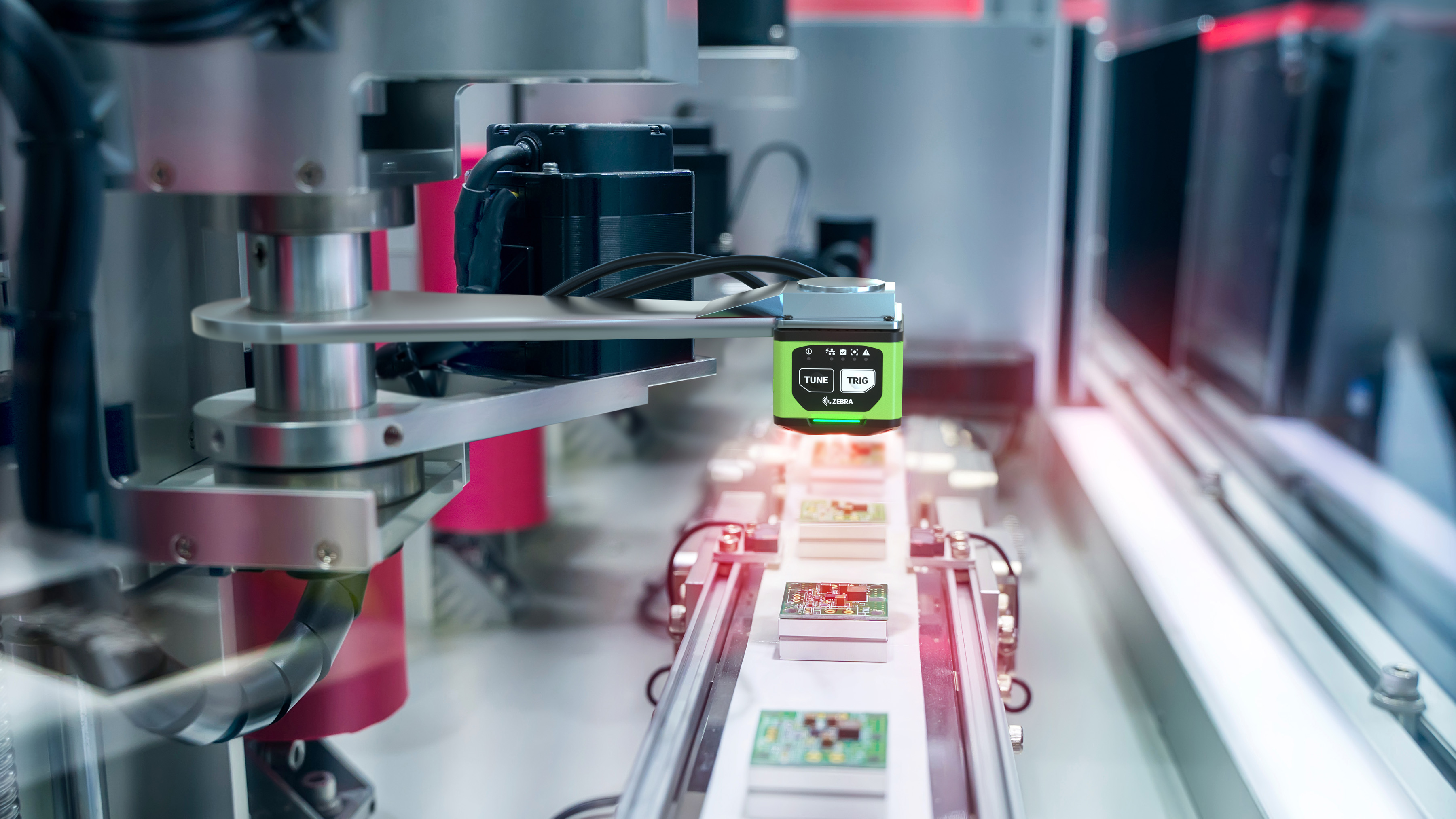
Machine Vision: What Is It?
Machine vision (MV) uses computer vision in industrial applications and processes, where it is necessary to execute a specific action or outcome based on the image processing and image analysis done by the vision system. Machine vision utilizes both hardware and software to help guide operations, relying on the images that are captured by the system. The machine vision system can process, analyze, and measure distinctive characteristics of the subject from the image capture. The information from the digital image is then used by the system for decision-making. Essentially, machine vision gives a system the ability to perceive the environment and perform objective measurements and decisions, which is why this technology is helpful and highly sought after by companies for executing industrial tasks reliably and consistently.
What Can Machine Vision Be Used For?
Machine vision can be used in many industries, from manufacturing to healthcare. Although machine vision is a technology that has been around for decades, it is only relatively recently that it can be used in a wide variety of applications. Machine vision allows industrial equipment to see and detect features or flaws, providing operational guidance to devices. The machine vision system can then use the acquired images to make fast decisions based on what it sees. Many companies rely on machine vision for visual inspection, process control, material inspection, and more.
Today, machine vision systems play an integral part in an inspection system and vision process, especially in industrial applications that require some type of visual feedback. Machine vision systems can be used for things like detecting defects in objects, identifying objects, tracking objects, sorting products, recognizing patterns and colors, pass or fail detection, and more.
With continuing advances in technology such as machine learning, deep learning, and more robust software, the future of machine vision is filled with many possibilities and an increasing number of applications that were not possible before.
To learn more, read about Machine Vision VS Computer Vision.
How Does Machine Vision Work?
1. Machine Vision Works By Using A Combination of Hardware, Software, and Electronic Components
Machine vision systems use hardware like cameras to see, along with using software to trigger various actions based on the analysis of an image. There is advanced machine vision software available today to help create custom machine vision applications depending on business needs and software technology to help monitor and manage machine vision systems.
2. Machine Vision Technology Uses Information that is Extracted from Digital Images to Make a Decision
Think of machine vision systems as a way to give industrial equipment the ability to see, analyze what it sees, and act based on that analysis. To properly see and detect objects, machine vision systems often require good lighting. This can involve placing a light source in a strategic way with respect to the camera of the machine vision system. When the image is processed, systems can be programmed to act a certain way depending on the criteria set. If machine vision detects a flaw, then the system can be programmed to exclude that specific item from the manufacturing line.
3. Continuous Innovation of Machine Vision Provides More Flexibility and Bigger Automation Possibilities
Today, machine vision is widely accepted for many applications, including quality control and automated inspection. This is because advances in technology have led to increased applications being solved using machine vision. These include process control and optical sorting, which includes removing undesirable stuff from bulk material. Other applications include robotic movement, which involves the positioning and orientation of items to be picked up by a robot arm.
How Accurate is a Machine Vision System?
The accuracy of a machine vision system depends on the camera's resolution, the field of view, and the size of the object/s that the system is inspecting or monitoring. We need to account for whether the system is looking at something which is the size of a postage stamp or a large piece of equipment (or something even larger, like a football field), all of which can affect the accuracy of the machine vision system.
For example, if you are using a system on a large football field, the accuracy would be less accurate than if you are looking at an object in a tiny field of view, such as a postage stamp.
An additional consideration is the camera's resolution, how many pixels are there to be able to resolve that image? The camera is looking for contrast changes within the pixels themselves, if a neighboring pixel changes brightness levels or the intensity changes, this can become a threshold, and then you can use interpolation software to increase the accuracy of the identification.
What is the Difference Between Machine Vision and Human Vision?
Human vision requires coordinating the eyes and the brain. Machine vision uses cameras and software to see, identify, distinguish, and classify items by size, color, or patterns using image capture. Human vision shines when it comes to qualitative interpretation of something complex and unstructured, and associating images with emotions. In contrast, machine vision shines when it comes to quantitative measurement of a structured environment. This is because of the machine vision system’s speed, accuracy, and repeatability, which the average human vision may not be able to keep up with.
How Quickly Can Machine Vision Systems Detect an Object or a Defect?
How fast machine vision systems can detect an object, features, or defects comes down to 3 core items that go hand in hand in terms of capturing and then processing:
1. The frame rate of the camera
2. The processing capabilities
3. The complexity of the job
The frame rate of the camera refers to how many frames per second it can capture. Once the image is captured, intelligence starts to analyze the image, which is where the system's computer vision comes into play.
The processing capabilities also play a major part, and this can depend on the complexity of the system and how it is being used. For example, are you using machine vision to measure an object/s? Are you checking for defects where it must compare a captured image to several other images that are within its database?
Nowadays, smart cameras are incredibly sophisticated, and IT (Information Technology) architectures are becoming more elaborate with the power of capturing, pre-processing, and processing all becoming more intelligent.
How Close or Far Can a Machine Vision System See When It Is Detecting an Object?
The distance that a machine vision system can see depends on a combination of optics, illumination, resolution, and the aperture of the camera system, all of which are interchangeable depending on the type of setup that is required.
The depth of field and focus affect how effectively a camera can image an object(s). For example, in a large depth of field which is what is in focus and what is not (everything that is in focus is your depth of field). For example, to get a large depth of field, this will require significant illumination and a lower aperture (as small as it will go), with most applications, this will give you a large depth of field. Therefore, lighting and illumination are incredibly important in several applications. This also has a lot to do with the resolving power and quality of the optics.
What are the Different Types of Machine Vision?
There tend to be two types of machine vision: the first type is a smart camera which is a combination of hardware and software in one “body” within one piece of self-contained hardware. Smart cameras are more prevalent across the market, but they do have limited capacity as the processing hardware is fixed.
Another type of machine vision is a vision system that uses a “dumb” camera connected to a controller, a PC or industrial PC, or a dedicated platform that a company may have created. These types of machine vision systems are more flexible. They are more tuned for specific functions, high-end applications, and more challenging tasks beyond the capability of a smart camera.
How is Machine Vision Useful in an Automated Inspection?
1. Machine Vision Can Increase the Product Quality that Gets Released to the World and Can Help Reduce Costs
Machine vision systems that are utilized for inspection help identify features or detect object defects, functional flaws, and physical irregularities in products, especially in manufacturing. For example, machine vision systems can be used to inspect bottles or containers and detect the presence of flaws. This helps increase the overall product quality that gets put out there outside of the manufacturing facility or factory.
2. Machine Vision Technology Helps Optimize Operations and Reduce Human Error
Human eyes can get tired after performing tedious inspection tasks over time. This can lead to an increase in errors. On the other hand, machine vision does not have this problem. Automated machine vision systems tend to be more accurate, reliable, and tireless for executing inspections that require the same tasks. This decrease in human error and increase in the speed of specific tasks can help reduce costs, both in terms of money and time.
What are the Typical Applications With Machine Vision?
Quality inspection and control are generally the biggest applications. Machine Vision systems can also replace human operators who could be performing manual inspections. Here are other top applications and functions of machine vision systems:
1. Overhead Hands-free Scanning
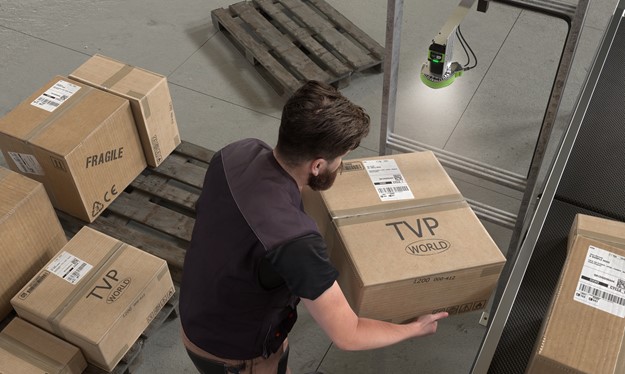
A fixed scanner can read 1D/2D code(s) on a product while the operator manually presents the product to the scanner.
2. In-Motion Tracking with Inline Scanning

A fixed scanner can read 1D/2D code(s) while a product or parcel moves on a conveyor belt.
3. Ensure Label Presence and Quality
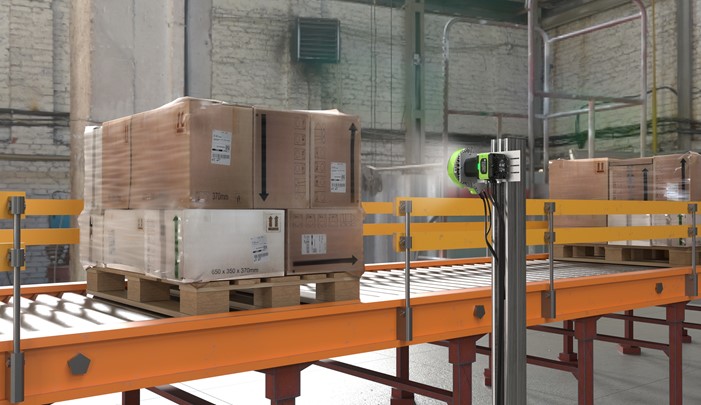
A fixed scanner can read 1D/2D code(s) directly after printing a label.
4. Confirm Label Presence and Placement
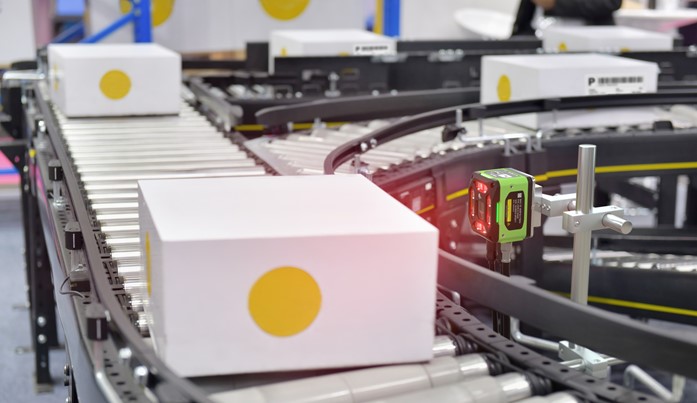
Machine Vision Systems can check for the following:
- Correct pre-printed label (Printing Supplies)
- Correct positioning of the label
- Sortation based on the courier logo
5. Label Integrity (Object Detection)
The system can perform a quality check whereby it checks for the presence/absence of print (print quality). In terms of functionality, a trained Model (shape or logo) must be located within the Search Region and the inspection will pass when the Model is present within the Search Region. These tools can also measure the Brightness or perform a Pixel Count and use a set of limits to set the inspection criteria. Products that exceed these limits will fail.
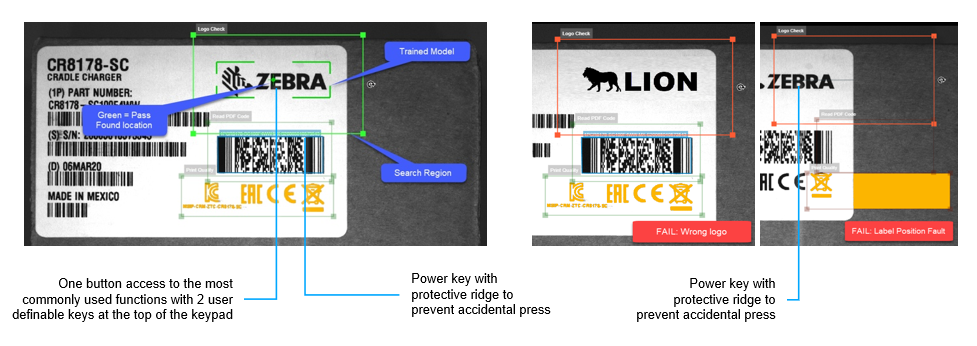
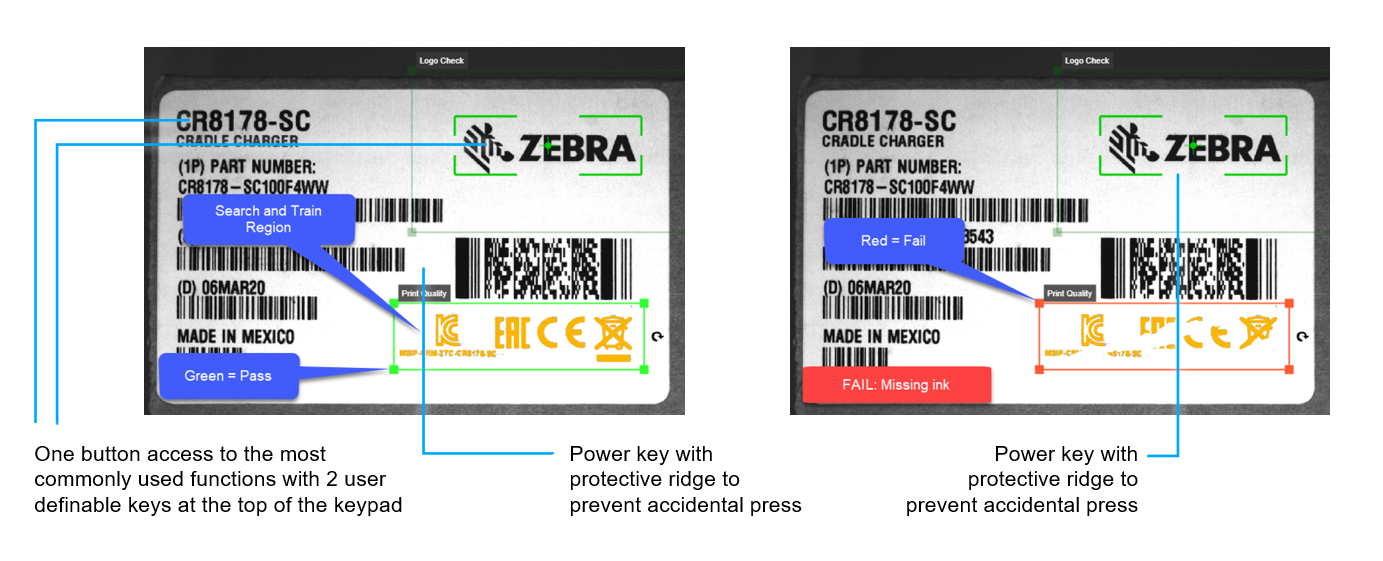
6. Assembly Verification (Presence/Absence Detection)
A vision camera checks visual if all components of an assembly are present for manual and automated assembly. This helps to improve quality along with improving productivity and efficiency via a fast and higher throughput.
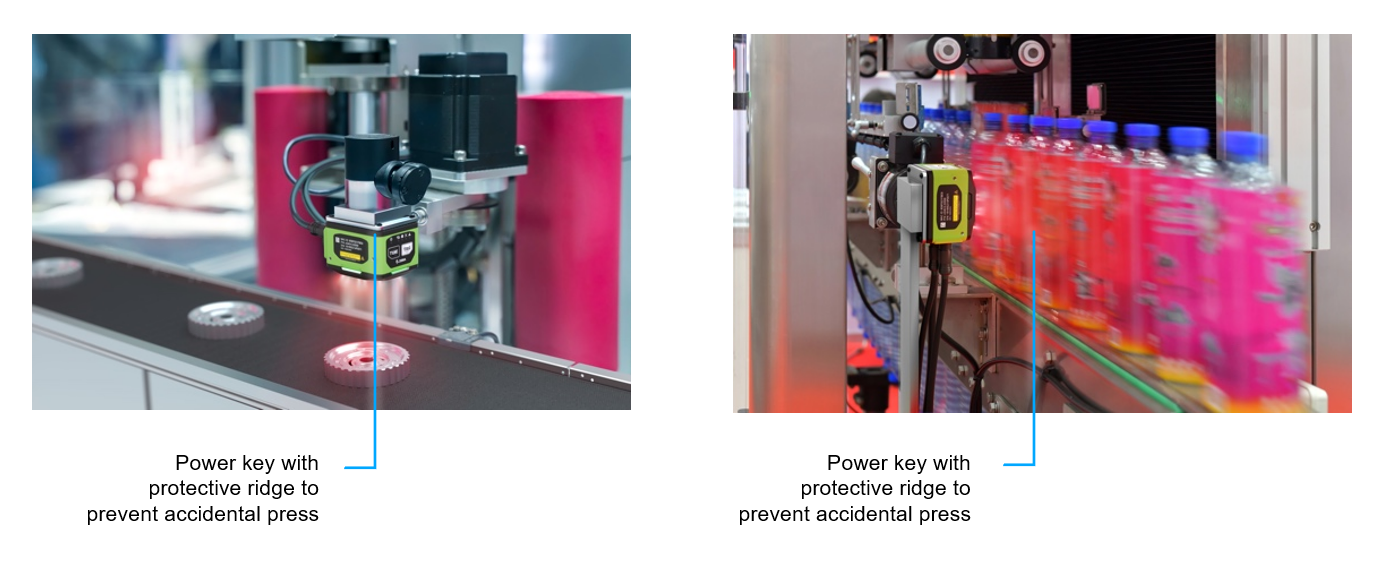
What are The benefits of Machine Vision?
The benefits of machine vision systems include:
- Reducing human interaction and inspection from a process
- Speed – on average, a camera can inspect parts much faster than a human can
- Consistency of inspection – machine vision provides more consistency compared to human inspection
- Ability to sustain a high level of inspection compared to humans (who, whilst still part of the process, may only be able to do it for a short period of time)
- Automating processes – reducing interaction between humans and machines
- Alongside this, you are also getting data from the images so you can understand. For example, if you are making a part that is 2 inches long and the production fluctuates between 2.25 inches and 1.75 inches, the system can learn and understand what is happening through the data that is produced and available. This is key to fully understanding what is going on in your processes to making that particular part. This provides automated data points and millions of data points on your products.
- Improve inspections, reduce costs, improve quality and remove the human element of Manufacturing
- Machine vision solutions give customers more flexibility with their operations
- A machine vision camera can read both 1D and 2D codes and do quality verification, part presence, and orientation; product defect detection; color inspection; and other visual inspection processes
- Machine vision systems can recognize text (OCR), handwriting (ICR), barcode (OBR), and optical mark (OMR)
- Computer vision, whether used with robots or in quality control systems in manufacturing processes, can process images or video and initiate appropriate actions
- With these capabilities, computer vision systems can conduct a wide range of tasks, well beyond that of barcode reading
- Machine vision can know what is in a standard cardboard box, carton, or other containers, so it is good for applications where the packaging has distinguishing characteristics
- It can determine sizes or styles, making it effective in many retail applications
Explore Our Products
Legal Terms of Use Privacy Policy Supply Chain Transparency
ZEBRA and the stylized Zebra head are trademarks of Zebra Technologies Corp., registered in many jurisdictions worldwide. All other trademarks are the property of their respective owners. ©2025 Zebra Technologies Corp. and/or its affiliates.

